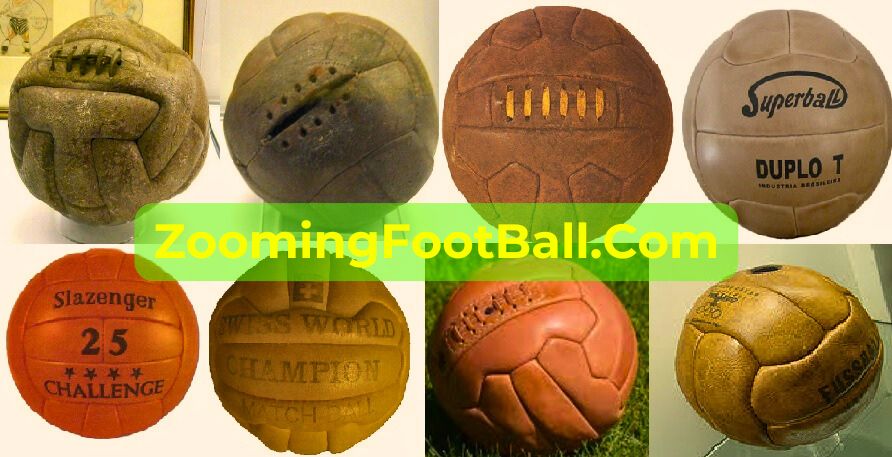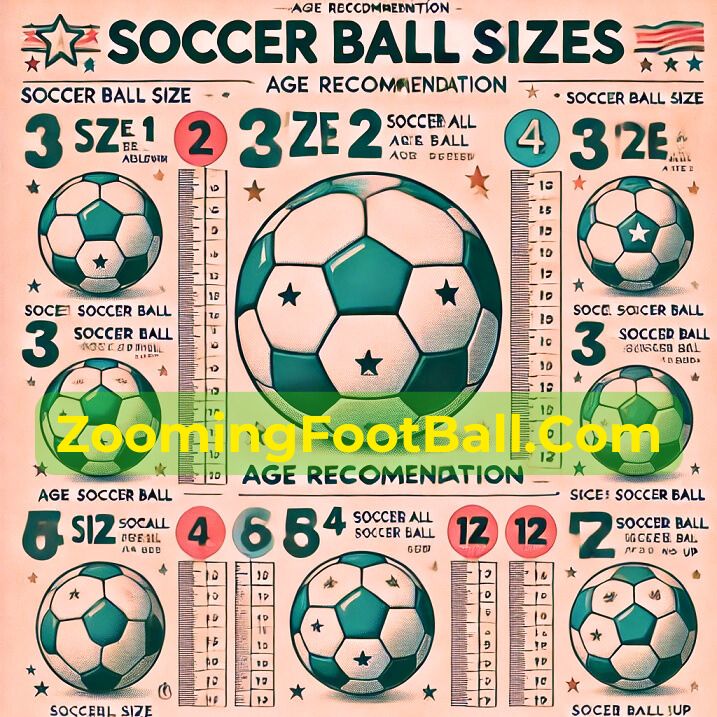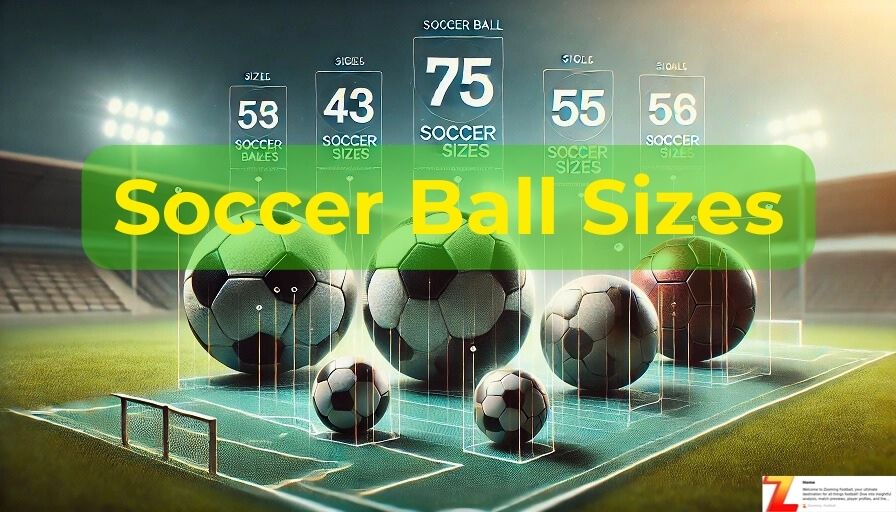Choosing the right soccer ball size is crucial for players of all ages, from young children to seasoned adults. Whether you’re a coach, parent, or player, understanding soccer ball sizes is key to improving skills and ensuring safety. In this guide, we’ll walk you through everything you need to know, from the size 1 soccer ball for toddlers to the size 5 soccer ball for professional matches.
History of Soccer Ball Sizes
Early Designs

The evolution of the soccer ball has been quite fascinating. In the early days, the balls were made from pig’s bladder wrapped in leather. This rudimentary construction made the ball heavy and difficult to control. As the sport grew, so did the need for better equipment, leading to the creation of more reliable balls.
Vulcanization and the Shift to Modern Balls
In the 19th century, Charles Goodyear pioneered the process of vulcanized rubber, which transformed ball construction. This advancement led to lighter, more durable balls. The shift to rubber made the soccer ball more consistent, ensuring better bounce and handling. Today, FIFA-approved balls with 32-panel designs are used in professional games.
Soccer Ball Sizes Explained
Soccer Ball Size Chart and Specifications
To make it easier for you, here’s a quick soccer ball size chart that shows the different sizes of soccer balls and their intended age groups:
| Ball Size | Age Group | Circumference | Weight |
| Size 1 | Toddler | 18–20 inches | 1–2 oz |
| Size 2 | Ages 3–5 | 20–22 inches | 2–3 oz |
| Size 3 | Ages 5–8 | 23–24 inches | 3–4 oz |
| Size 4 | Ages 8–12 | 25–26 inches | 3.5–4.5 oz |
| Size 5 | 12 and up | 27–28 inches | 4.5–5 oz |
FIFA-Approved Soccer Ball Sizes
The FIFA sets the standard for soccer ball specifications in professional matches. The size 5 soccer ball is the official regulation size for adult games, including international tournaments like the FIFA World Cup. For younger players, smaller balls like size 3 soccer balls or size 4 soccer balls are ideal to help develop their skills at an age-appropriate level.
Choosing the Right Soccer Ball by Age
Size 1 Soccer Ball (Toddler)
For toddlers or very young players, a size 1 soccer ball is perfect. Its small size and light weight help little players learn basic motor skills, such as dribbling and ball control, without feeling overwhelmed. Manufacturers make the soccer ball for toddlers from soft materials, ensuring safety during play.
Size 2 and 3 Soccer Balls (Ages 3-8)
As children grow, they’ll move on to a size 2 soccer ball and eventually a size 3 soccer ball. These sizes are ideal for younger children and help them develop their touch technique and control. Youth leagues widely use a size 3 soccer ball, and youth soccer ball sizes offer more bounce and control than a mini soccer ball.
Size 4 Soccer Ball (Ages 8-12)
The size 4 soccer ball is great for players aged 8–12. This ball is the next step before transitioning to a size 5 soccer ball. It’s used in most youth soccer leagues and youth players can benefit from practicing with it. It prepares players for the next level of play by improving their ball control, passing, and shooting.
Size 5 Soccer Ball (Ages 12 and Up)
Finally, players aged 12 and up should use the size 5 soccer ball, which is the official soccer ball size for professional matches. This ball is the standard used in leagues like MLS, EPL, and La Liga. A size 5 soccer ball has a soccer ball circumference of 27–28 inches, making it ideal for competitive play.

What Else Influences Soccer Ball Choice?
Skill Level
Skill level also plays a role in choosing the right soccer ball size. Advanced players may prefer using a smaller training soccer ball to work on specific skills like tight ball control. Smaller balls force players to be more precise with their touches.
League Regulations
Each league or tournament has its own soccer ball regulations. It’s important to ensure that the ball complies with the required FIFA soccer ball standards for your event. This ensures fair play and consistency in competition, whether it’s a youth league or a professional match.
You may also like this: History of Soccer ball, Manufacturing, Materials, Innovations & Impact.
Player Preference
Some players may prefer certain soccer ball dimensions based on their playing style. For example, players who specialize in set pieces like free kicks or corners might opt for a ball with a specific weight or texture for better control.

Soccer Ball Materials and Construction
Common Materials
Soccer balls are made from various materials, including synthetic leather, vulcanized rubber, and PVC. The choice of material impacts the ball’s weight, bounce, and durability. Professional balls often feature synthetic leather for a smooth touch, while training balls may use a tougher material for extended wear.
You may also like this: Types of Soccer Balls
Panel Construction
The 32-panel design is a classic construction method that provides great control and durability. Some training footballs might have fewer panels, which can affect the ball’s flight. It’s important to choose a ball with the right panel design for the type of training or match you’re participating in.
Fun Facts about Soccer Ball Sizes
Soccer balls have come a long way from their humble beginnings. Whether you’re playing with a size 1 soccer ball for toddlers or a size 5 soccer ball in a professional match, it’s fascinating to see how far the sport has evolved.
Here are some fun facts about soccer ball sizes that you may not know:
Soccer Balls Were Once Made of Pig Bladders
In the early days, soccer balls were made from pig’s bladder, covered in leather. They were far from the modern, synthetic balls we see today. Can you imagine playing with one of those?
The Classic 32-Panel Design
The iconic 32-panel soccer ball design is based on the shape of a truncated icosahedron (a type of polyhedron). This design provides great ball control and makes the ball more durable for intense games.
The FIFA World Cup Ball Changes Every Time
Each FIFA World Cup tournament has its own unique official match ball, with different designs and technologies. Adidas released famous balls like the Telstar, used in the 1970 World Cup, and the Tango España, used in 1982.
The Heavy History of Soccer Balls
Before Charles Goodyear introduced the vulcanization process in the 1800s, soccer balls were heavy, irregularly shaped, and hard to control. Vulcanized rubber helped revolutionize the design, making them lighter and bouncier.
Size Matters for Kids
Did you know that soccer balls for kids are specifically designed to be easier to control? A size 3 soccer ball, used for players aged 5–8, is much smaller and lighter than the size 5 soccer ball used in professional leagues. This makes learning to dribble and pass more manageable for younger players.
More Facts about Soccer Ball Sizes
The Power of Futsal
The futsal ball, which is used for indoor soccer, is heavier than a regular soccer ball, which helps improve ball control. Futsal players often have better dribbling and quick decision-making skills because of their training with the smaller, heavier ball.
Size 5 Balls are Standard in Professional Games
The size 5 soccer ball is used in professional matches across the world, including major leagues like MLS, La Liga, and EPL. This regulation size ensures consistency in play, no matter where you’re playing.
Soccer Balls Aren’t Just for the Pitch
You might be surprised to learn that soccer balls are used for a variety of other purposes too! Some people use them as exercise equipment, like for balance exercises or even as a medicine ball for workouts.
Indoor and Outdoor Balls are Different
Players use the indoor soccer ball, which is often smaller and heavier, while manufacturers design the outdoor soccer ball to handle rougher surfaces. So, next time you hit the field, make sure you have the right ball for the environment.
The Microchip Revolution
Some modern soccer balls even have microchips built into them to track performance and analyze data such as ball speed and trajectory. These “smart balls” are helping players improve their game with data-driven insights.
Frequently Asked Questions
What is the official soccer ball size for professional matches?
The size 5 soccer ball serves as the official ball in professional matches like the World Cup, MLS, and EPL games. It’s the regulation size for adult competitions.
Can adults train with smaller-sized balls?
Yes, adults can train with smaller balls, such as the size 4 soccer ball or even the size 3 soccer ball, for specialized training, such as improving ball control or touch technique.
Are futsal balls different from regular soccer balls?
Yes, futsal footballs are smaller and heavier than regular soccer balls. Manufacturers design these balls for the smaller playing surface of futsal courts and provide better traction and control on indoor surfaces.
Conclusion
Choosing the right soccer ball size is crucial for any player, regardless of age or skill level. By understanding the soccer ball size guide, you can ensure that players get the most out of their training and enjoy the game safely. Remember to always check the soccer ball specifications and soccer ball measurements to make sure you’re using the right equipment for your age and playing level. Whether you’re buying a size 1 soccer ball for toddlers or a size 5 soccer ball for adults, the right ball can make all the difference in skill development and performance.

Oliver Brown, a seasoned football blogger with a knack for insightful commentary, brings decades of passion and expertise to Zooming Football. Known for his sharp analysis and engaging storytelling, Oliver delves deep into the game’s nuances, offering readers a unique perspective on football’s most captivating stories and strategies.







